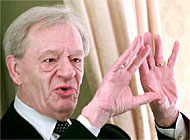Bergier commission reports on Swiss wartime role

The Independent Commission of Experts (ICE), charged with probing Switzerland's role during the Second World War, begins a series of publications on Thursday, which wrap up its four-to-five-year inquiry by the end of the year. The first batch focuses on Switzerland's financial and industrial links with Nazi Germany.
The eight studies form part of a total of 25 publications that a team of 50 historians, researchers and experts have prepared under the supervision of the ICE and its chairman, Jean-François Bergier. Of the total, 17 publications are detailed historic “studies”, six are “research contributions”, and two are legal expert opinions.
The ICE, established by parliamentary decision in 1996 and mandated to investigate the volume and fate of assets moved to Switzerland before and during the world war, is under obligation to wrap up its research by the end of 2001. Another series of detailed studies will be published towards the end of the year, while the commission’s final report is expected in the first half of 2002.
The ICE has been controversial since its inception, with associations of wartime veterans and right-wing parties claiming that its historians were out to establish a collective guilt of the Swiss where none was warranted. The ICE’s two previous publications, two interim reports on gold transactions during the Second World War in 1998, and on Switzerland’s wartime refugee policy in 1999, drew heavy criticism.
Less controversy expected
The studies due out now will probably be less controversial. This is partly due to the political interest in Switzerland’s wartime role having abated in the wake of the $1.25 billion (SFr2.09 billion) settlement reached in August 1998 between Swiss banks and Jewish plaintiffs. Another reason is that the historic studies are of more interest to academics than to conflicting political interpretations.
However, the ICE’s final report, which it heralds as a “synthesis” of its four-year mandate, due next year, is almost certain to rekindle the prolonged debate that the ICE — known simply as the “Bergier commission” in Switzerland — has caused around family tables and in the media’s opinion pages.
Of the eight published studies, two stand out. One covers the use of slave labour by German subsidiaries of Swiss-owned enterprises. The other concerns Interhandel, a Swiss subsidiary of the Nazi chemical giant, I.G. Farben.
I.G. Farben supervised all its US subsidiaries before the war through I.G. Chemie, a subsidiary based in Basel, Switzerland. When the US entered the war in 1941, I.G. Chemie was spun off under unknown circumstances and became the officially Swiss-owned firm, Interhandel.
Disguised assets?
But suspicion lingered that the operation was a failed attempt to disguise I.G. Farben assets, especially in the US. The US government confiscated I.G. Farben’s former subsidiaries on its territory as “enemy property” during the war, but compensated the Swiss Bank Corporation (SBC), which had acquired Interhandel after the war, in a settlement in the 1960s. SBC later merged with Union Bank of Switzerland to form UBS.
A Swiss investigation into the I.G. Chemie/Interhandel spin-off in 1946 first confirmed Interhandel’s position that it was a bona fide Swiss company. However, when the Swiss government ordered a second investigation shortly afterward, its findings were sealed with an official secrecy stamp and its author, federal auditor Albert Rees, bound by a secrecy act.
But Rees, who is 86, had his obligation to remain silent lifted for the purpose of the ICE’s investigations and was interviewed by historian Mario König, author of the Interhandel study which is currently being published.
The other studies to be published this week also deal with financial and economic transfers between Switzerland and the axis powers (Germany and Italy) between 1933 and 1945: works of art; financial clearing transactions involving the Swiss national bank; railway traffic; trade in electric power; Switzerland’s chemical industry and the “Third Reich”. One study focuses on how the government communicated its (now controversial) refugee and foreign trade policies between 1938 and 1950.
The ICE’s 26 studies will be published in one language only – either in French or German. However, the ICE’s final report will be published in both languages, as well as in Italian and English.
by Markus Haefliger

In compliance with the JTI standards
More: SWI swissinfo.ch certified by the Journalism Trust Initiative
You can find an overview of ongoing debates with our journalists here. Please join us!
If you want to start a conversation about a topic raised in this article or want to report factual errors, email us at english@swissinfo.ch.